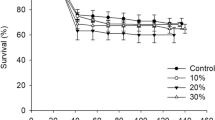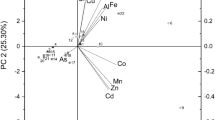Summary
Senescent floating leaf material of Nymphaea alba L., collected in an acidified moorland pool, was used in decomposition studies in two aquatic systems that differed greatly in pH, alkalinity and nutrient concentration. Concentrations of extractable protein and phenolics in the decomposing leaf material were measured during the incubation period. Protein levels were not significantly different in the leaf material from the two study sites, whereas the concentrations of phenolics in the degrading leaf blades from the acid site remained higher than in the material from the alkaline site. The resource quality of the decomposing leaf material was estimated by feeding tests using Asellus aquaticus (L.) in the laboratory. The effect of an artificially increased level of tannin on the feeding activity of A. aquaticus was also studied. Material from the acid system was consumed at a lower rate than material from the other system. The phenolic content of the material was found to be the most important feeding cue. The protein level of the leaf blade detritus seems to be of less importance. The structure of the decomposing leaf blades may have influenced the resource quality in the later stages of the experiment.
Similar content being viewed by others
References
Bärlocher F, Kendrick B (1973a) Fungi and food preference of Gammarus pseudolimnaeus. Arch Hydrobiol 72:501–516
Bärlocher F, Kendrick B (1973b) Fungi in the diet of Gammarus pseudolimnaeus (Amphipoda). Oikos 24:295–300
Bärlocher F, Kendrick B (1975) Leaf conditioning by microorganisms. Oecologia 20:359–362
Bärlocher F, Kendrick B (1981) Role of aquatic hyphomycetes in the trophic structure of streams. In: Wicklow DT, Carrol GC (eds) The fungal community, its organization and role in the ecosystem. New York Basel, pp 743–761
Basaraba J, Starkey RL (1966) Effect of plant tannins on decomposition of organic substances. Soil Sci 101:17–23
Brock TCM (1984) Aspects of the decomposition of Nymphoides peltata (Gmel.) O. Kuntze (Menyanthaceae). Aquat Bot 19:131–156
Brock TCM, Boon JJ, Paffen BGP (1985) The effects of the season and of water chemistry on the decomposition of Nymphaea alba L.; weight loss and pyrolysis mass spectrometry of the particulate matter. Aquat Bot 22:197–229
Buchsbaum R, Valiela I, Swain T (1984) The role of phenolic compounds and other plant constituents in feeding by Canada geese in a coastal marsh. Oecologia 63:343–349
Chamier AC (1987) Effect of pH on microbial degradation of leaf litter in seven streams of the English Lake District. Oecologia 71:491–500
Chamier AC, Dixon RA (1982) Pectinases in leaf degradation by aquatic Hyphomycetes II. The enzymes and leaf maceration. J Gen Microbiol 128:2469–2483
Cummins KW (1973) Trophic relations of aquatic insects. Annu Rev Entomol 18:183–206
Hagermann AE, Butler LG (1980) Determination of protein in tannin-protein precipitates. J Agric Food Chem 28:944–947
Harrison AF (1971) The inhibitory effect of oak leaf litter tannins on the growth of fungi, in relation to litter decomposition. Soil Biol Biochem 3:167–172
Harrison PG, Mann KH (1975) Detritus formation of eelgrass (Zostera marina L.) The relative effects of fragmentation, leaching and decay. Limnol Oceanogr 20:924–934
Kaushik NK, Hynes HBN (1971) The fate of dead leaves that fall into streams. Arch Hydrobiol 68:465–515
Kok CJ, Van der Velde G (1991) The influence of selected water quality parameters on the decay rate and exoenzymatic activity of detritus of Nymphaea alba L. floating leaf blades in laboratory experiments. Oecologia 88:311–316
Kok CJ, Meesters HWG, Kempers AJ (1990a) Decomposition rate, chemical composition and nutrient recycling of Nymphaea alba L. floating leaf blade detritus as influenced by pH, alkalinity and aluminium in laboratory experiments. Aquat Bot 37:215–227
Kok CJ, Van der Velde G, Landsbergen KM (1990b) Production, nutrient dynamics and initial decomposition of floating leaves of Nymphaea alba L. and Nuphar lutea (L.) Sm. (Nymphaeaceae) in alkaline and acid waters. Biogeochemistry 11:235–250
Leuven RSEW, Wolfs WJ (1988) Effects of water acidification on the decomposition of Juncus bulbosus L. Aquat Bot 31:57–81
Lindroth RL (1989) Biochemical detoxification: Mechanisms of differential swallowtail tolerance to phenolic glycosides. Oecologia 81:219–225
Lodge DM (1991) Herbivory on freshwater macrophytes. Aquat Bot 41:195–224
Loomis WD (1974) Overcoming problems of phenolics and quinones in the isolation of plant enzymes and organelles. Meth Enzymol 31:528–544
Mackay RJ, Kersey KW (1986) A preliminary study of aquatic insect communities and leaf decomposition in acid streams near Dorset, Ontario. Hydrobiologia 122:3–11
Mann KH (1975) Patterns of energy flow. In: Whitton BA (ed) River Ecology. Oxford, pp 248–263
Marcus JH, Suttcliffe DW, Willoughby LG (1978) Feeding and growth of Asellus aquaticus on food items from the littoral of Windermere, including green leaves of Elodea canadensis. Freshw Biol 8:505–519
McClure JW (1970) Secondary constituents in aquatic angiosperms. In: Harborne JB (ed): Phytochemical Phylogeny. Academic Press, London New York, pp 233–268
Nicolai V (1988) Phenolic and mineral content of leaves influences decomposition in European forest ecosystems. Oecologia 75:575–579
Palo RT (1985) Chemical defence in birch: Inhibition of digestibility in ruminants by phenolic extracts. Oecologia 68:10–14
Petridis D (1990) Utilization of grass carp faeces by the isopod Asellus aquaticus (L.) in the laboratory. Hydrobiologia 194:47–56
Prus T (1976) Experimental and field studies on ecological energetics of Asellus aquaticus L. (Isopoda). I. Assimilability of lipids, proteins and carbohydrates. Ekol Pol 24:461–472
Rao SS, Dutka BJ (1983) Influence of acid precipitation on bacterial populations in lakes. Hydrobiologia 98:153–157
Read SM, Northcote DH (1981) Minimalization of variation in the response to different proteins of Coomassic Blue G Dye-binding assay for protein. Anal Biochem 116:53–64
Rice DL (1982) The detritus nitrogen problem: New observations and perspectives from organic geochemistry. Mar Ecol Prog Ser 9:153–182
Rossi LD, Vitagliano-Tadini G (1978) Role of adult faeces in the nutrition of larvae of Asellus aquaticus (Isopoda). Oikos 30:109–113
Valiela I, Rietsma CS (1984) Nitrogen, phenolic acids and other feeding clues for salt marsh detritivores. Oecologia 63:350–356
Valiela I, Wilson J, Buchsbaum R, Rietsma C, Bryant D, Foreman K, Teal J (1984) Importance of chemical composition of salt marsh litter decay rates and feeding by detritivores Bull Mar Sci 35:261–269
Van der Velde G, Van der Heyden LA (1985) Initial decomposition of floating leaves of Nymphoides peltata (Gmel.) O. Kuntze (Menyanthaceae) in relation to their age, with special attention to the role of herbivores. Werh Internat Verein Limnol 22:2937–2941
Van der Velde G, Van der Heyden, LA, Van Grunsven, PAJ, Bexkens, PMM (1982) Initial decomposition of Nymphoides peltata (Gmel.) O. Kuntze (Menyanthaceae) as studied with the leaf marking method. Hydrobiol Bull 16:51–60
Van der Velde G, Custers CPC, De Lyon MJM (1986) The distribution of four nymphaeid species in the Netherlands in relation to selected abiotic factors. EWRS/AAB 7th Symp Aquat Weeds (Loughborough) pp 363–368
Van Sumere CF, Albrecht J, Dedonder A, de Pooter H, Pé I (1975) Plant proteins and phenolics. Annu Proc Phytochem Soc 11:211–264
Wetzel RG (1975) Primary production. In: Whitton BA (ed) River Ecology. Oxford, pp 230–247
Willoughby LG, Marcus JH (1979) Feeding of the isopod Asellus aquaticus on Actinomycetes, considered as a model filamentous bacteria. Freshw Biol 9:441–449
Author information
Authors and Affiliations
Rights and permissions
About this article
Cite this article
Kok, C.J., Hof, C.H.J., Lenssen, J.P.M. et al. The influence of pH on concentrations of protein and phenolics and resource quality of decomposing floating leaf material of Nymphaea alba L. (Nymphaeaceae) for the detritivore Asellus aquaticus (L.). Oecologia 91, 229–234 (1992). https://doi.org/10.1007/BF00317788
Received:
Accepted:
Issue Date:
DOI: https://doi.org/10.1007/BF00317788




